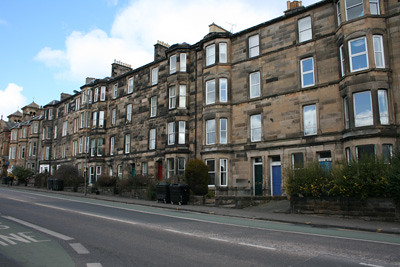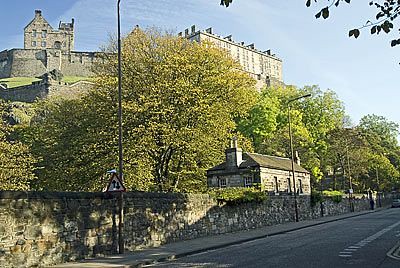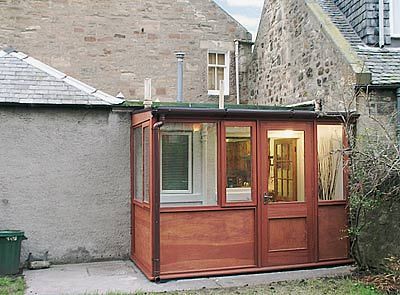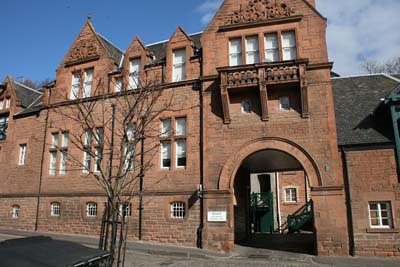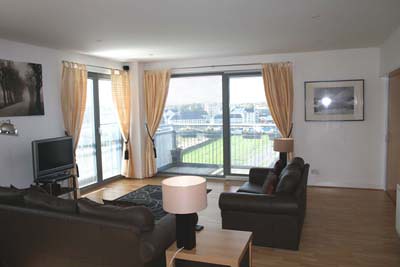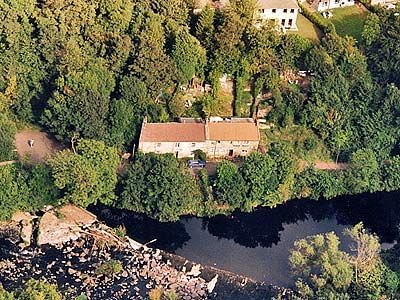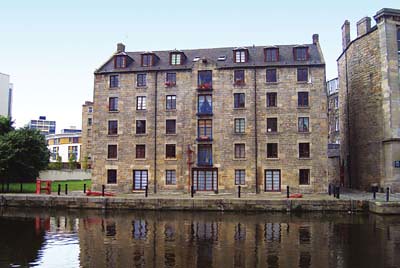Edinburgh West End also spread northwest along Queensferry Street towards Melville Street, the most impressive thoroughfare in the West End. At its western end in Palmerston Place, is St Mary's Cathedral, the second-largest church in Scotland, designed by George Gilbert Scott in Gothic style, and featuring a set of murals by Phoebe Traquair.
The western extension of the New Town followed a couple of years after the eastern extension and spread southwest from Shandwick Place, along West Maitland Street to Haymarket, whose railway station was built in 1840 as the original terminus of the line from Glasgow, before it was extended east to Waverley. It also spread northwest along Queensferry Street towards Melville Street, the most impressive thoroughfare in the West End. At its western end in Palmerston Place, is St Mary's Cathedral, the second-largest church in Scotland, designed by George Gilbert Scott in Gothic style, and featuring a set of murals by Phoebe Traquair.
Queensferry Street follows the old coaching route to South Queensferry and soon reaches the wooded valley of the Water of Leith, the little river which flows from the Pentland Hills to the port of Leith where it enters the Firth of Forth. The road crosses the steep valley along the 100-ft-high Dean Bridge, a remarkable feat of engineering, built by Thomas Telford in the 1830s. At one time, the Water of Leith powered over 70 mills and below the bridge is Dean Village a picturesque old milling community which has been revitalized with the conversion of some of the mills into designer flats. From here you can walk along the river into neighbouring Stockbridge, past St Bernard's Well, a mineral spring covered by a mock Doric temple. It has recently been restored and is sometimes open to the public, but take note that the waters were once described as having "a slight resemblance in flavour to the washings of a foul gun barrel".
At the north end of Dean Bridge, to the west of Trinity Church, is Dean Cemetery, one of Edinburgh's finest places of final rest. The cemetery houses the graves of the likes of architect William Playfair, pioneering photographer Octavius Hill, and Dr Joseph Bell, who is said to have been the flesh-and-blood inspiration for Arthur Conan Doyle's character Sherlock Holmes. It also contains many excellent examples of 19th-century sculpture.
About 10 minutes' walk from Dean Village, set in spacious wooded grounds along Belford Road, is the Scottish National Gallery of Modern Art , which is definitely worth visiting, even if you know nada about Dada. It opened to the public in 1984 as the first ever gallery in Britain devoted to 20th century art. The hugely-impressive permanent collection features everything from the Impressionists to Hockney and is now second in Britain only to the Tate Museums in London. It is particularly strong on Expressionism, with works by Picasso, Cezanne, Matisse, Magritte, Mondrain, Henry Moore, Kandinsky, Klee, Giacometti and Sickert all displayed, among many other important names, including many contemporary Scottish artists. There are also frequent temporary exhibitions, and don't miss the excellent café, especially if the sun is shining. Across the street is the new Dean Gallery (same opening hours as above and also free), featuring the work of Edinburgh-born artist Sir Eduardo Paolozzi. It also houses a major Dada and Surrealist collection and exhibitions of contemporary art. _ Both galleries open Mon-Sat 1000-1700, Sun 1400-1700. Free. A free bus leaves the National Gallery and visits the Portrait Gallery then these galleries. It leaves the National Gallery at 1100 and every hour on the hour till 1600. For more details Tel: 6246200.
Three miles west of the city centre, is Edinburgh's Zoo, by far the largest in Scotland, set in 80 acres on the side of Corstorphine Hill. Whatever you think of zoos, this one is highly respected for its serious work as well as being an enormous amount of fun. There are over 1,000 animals from all over the world, but the zoo is best known for its penguins – the largest breeding colony of Antarctic penguins anywhere outside Antarctica itself. You can watch the famous penguin parade at 1400 daily (March-October weather permitting) and see them swimming underwater in the world's largest penguin pool. The latest attractions are the endangered Asiatic lions and the Magic Forest, full of marmosets and tamarins. There are also animal handling sessions, available at an extra £1 per person, and afternoon animal talks (ask for details at the zoo entrance). _ Apr-Sep daily 0900-1800; Oct-Mar 0900-1630. £7, £4 child. Tel: 3349171, http://www.edinburghzoo.org.uk, there are numerous buses from Haymarket and Princes St.


